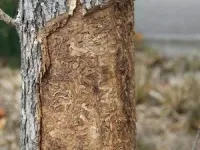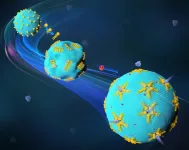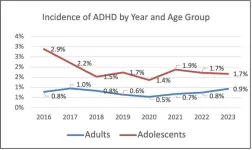(Press-News.org) UNIVERSITY PARK, Pa. — The invasive emerald ash borer, according to the U.S. Department of Agriculture, was first found in the United States in southeast Michigan in 2002. In the decades since, the wood-boring beetle has spread east and west across the U.S. and Canada, killing tens of millions of ash trees, causing one of the costliest forest insect invasions to date. More than 90% of all ash infested by the insect native to Asia eventually die, threatening to make the tree species functionally extinct in North America. In response, researchers at Penn State are working with the U.S. Forest Service and other partners to identify and develop ash trees genetically able to withstand the beetles’ onslaught and strategize how to restore ash to forests.
Since 2019, scientists in Penn State’s Louis W. Schatz Center for Tree Molecular Genetics have focused research efforts on Oregon ash (Fraxinus latifolia), a species that plays a critical role in the Pacific Northwest by providing wildlife habitats, stabilizing streambanks with an extensive root system, keeping waterways cool through shade and serving as a food source for birds and insects.
In a study recently published online before inclusion in a print edition of Molecular Ecology, the researchers found significant genomic variation across the range of Oregon ash. The genetic makeup of the trees that stretch from California to British Columbia varies, the researchers found, depending on their location in the species’ range, influenced by demography, range connectivity and environmental adaptation. This variability could inform the development of hardier ash trees, resistant to both the invasive beetles and rising temperatures — critical needs, the researchers said, because no other tree species occupies its niche in the region’s ecological balance.
Estimates of the genomic change required to adjust to future climate projections, known as genomic offset, were greatest in the northeastern and lowest in the southern portions of the species’ range, according to the researchers. These findings, they explained, suggests that the regional distribution of genomic variation may be critical to the trees’ long-term survival.
“The emerald ash borer recently has been observed in Oregon and British Columbia, and we know what to expect in terms of mortality in Oregon ash,” said study senior author Jill Hamilton, associate professor in ecosystem science and management and director of the Schatz center. “Our research aims to quantify and preserve genetic diversity for future resistance breeding efforts. Penn State is leading international conservation genetics efforts to preserve genetic diversity across ash species that will be critical to developing breeding and reforestation programs.”
To reach their conclusion, the researchers analyzed genomic variation from more than 1,000 individual trees from 61 separate populations around the Oregon ash range, extending from California, Oregon and Washington into British Columbia. Sequencing of the samples collected by researchers from Penn State, the Forest Service and other partners revealed that, despite evidence of connectivity between populations of Oregon ash, the patchy distribution of populations may impact the tree species’ long-term evolutionary potential.
To develop breeding programs that will produce climate-resilient, emerald ash borer-resistant trees, it will be necessary to prioritize conservation of range-wide genomic diversity, Hamilton pointed out.
“Leveraging the power of landscape genomics enables us to identify regions and Oregon ash populations of greatest conservation concern and can improve selection of populations for expanding collections for the breeding programs,” she said. “Given the immediate risk of the emerald ash borer to the Oregon ash range, there is a need for proactive conservation. This study represents the first application of genomic data to conservation and restoration for Oregon ash.”
Anthony Melton, who was a postdoctoral scholar at Penn State and is now professor of biology at the University of Montevallo in Alabama, spearheaded the study.
Contributing to the research were Trevor Faske, Southwest Biological Science Center, U.S. Geological Survey, Flagstaff, Arizona; Richard Sniezko, Dorena Genetic Resource Center, U.S. Forest Service, Cottage Grove, Oregon; Tim Thibault, The Huntington, San Marino, California; Wyatt Williams, Forests Resources Division, Oregon Department of Forestry; and Thomas Parchman, Department of Biology, University of Nevada Reno.
The U.S. Department of Agriculture National Institute of Food and Agriculture supported this work.
END
Ash tree variability may offer restoration path post-beetle decimation
Researchers found that genetic diversity is key to breeding ash trees resistant to emerald ash borers and rising temperatures
2025-01-13
ELSE PRESS RELEASES FROM THIS DATE:
Integrating CRISPR and biomaterials engineering: Paving the way for safer gene therapies
2025-01-13
CRISPR is a powerful gene-editing tool that holds enormous potential for treating genetic diseases by allowing scientists to cut, replace, or delete mutations in DNA. It can also modify gene expression, temporarily amplifying or diminishing its effects.
Yet, despite its promise, applying CRISPR (which is a reagent, or a substance that facilitates a reaction) in patients presents significant challenges.
“CRISPR is difficult to control when you want to do gene editing in vivo, or directly in the patient,” says Tomas Gonzalez-Fernandez, an assistant professor of bioengineering in Lehigh University’s P.C. Rossin College of Engineering ...
New tool for synthetic biology
2025-01-13
Scientists at the University of Stuttgart have succeeded in controlling the structure and function of biological membranes with the help of "DNA origami". The system they developed may facilitate the transportation of large therapeutic loads into cells. This opens up a new way for the targeted administration of medication and other therapeutic interventions. Thus, a very valuable instrument can be added to the toolbox of synthetic biology. Prof. Laura Na Liu and her team published their findings in the journal Nature Materials (DOI: 10.1038/s41563-024-02075-9).
The ...
Yu & Martin adapting mixed reality training programs to real-world scenes to enhance human-AI teaming in emergency responses
2025-01-13
Lap Fai (Craig) Yu, Associate Professor, Computer Science, College of Engineering and Computing, and Joel Martin, Associate Professor, Kinesiology, College of Education and Human Development, received funding for the project: “EAGER: TaskDCL: Adapting Mixed Reality Training Programs to Real-World Scenes to enhance Human-AI Teaming in Emergency Responses.”
This EArly-concept Grant for Exploratory Research (EAGER) project funds research that intends to speed up the development of mixed reality and artificial intelligence (AI) technologies to help ...
ExxonMobil donates $10 million to fund MD Anderson-led Be Well™ Beaumont initiative
2025-01-13
HOUSTON and BEAUMONT, TEXAS ― In an effort to improve public health and reduce cancer risk in East Texas, leaders in Beaumont are working with The University of Texas MD Anderson Cancer Center to launch Be Well™ Beaumont through a newly announced $10 million gift from ExxonMobil. Community members, collaborators and representatives from MD Anderson kicked off the 10-year initiative today in Beaumont.
Be Well Beaumont aims to promote wellness and to lower cancer risk among community members by providing them with cancer prevention education and tools. ...
Long reads successfully used to find genetic causes of rare diseases
2025-01-13
The cause of rare diseases is increasingly being detected through genome sequencing, which involves reading the entire human DNA by first breaking it into small pieces—short reads. Christian Gilissen, Lisenka Vissers, and colleagues found that a new technique using long reads is even more effective at detecting complex causes. They report that eighty to ninety percent of cases were detectable, as stated in the American Journal of Human Genetics.
Rare diseases are typically due to genetic causes. These causes are more and ...
X-ray flashes from a nearby supermassive black hole accelerate mysteriously
2025-01-13
One supermassive black hole has kept astronomers glued to their scopes for the last several years. First came a surprise disappearance, and now, a precarious spinning act.
The black hole in question is 1ES 1927+654, which is about as massive as a million suns and sits in a galaxy that is 100 million light-years away. In 2018, astronomers at MIT and elsewhere observed that the black hole’s corona — a cloud of whirling, white-hot plasma — suddenly disappeared, before reassembling months later. The brief though dramatic shut-off was a first in black hole astronomy.
Members of the MIT team have now caught the same black hole exhibiting ...
New research highlights trends in ADHD diagnoses
2025-01-13
New research identifies differing trends in attention-deficit/hyperactivity disorder (ADHD) diagnoses among adolescents and adults, including an increase among adults from 2020 to 2023. The study, published in the American Psychiatric Association Journal Psychiatric Research and Clinical Practice, found a significant downward trends in ADHD incidence among adults from 2016 to 2020 and adolescents from 2016 to 2018. The ADHD incidence rate remained stable for adolescents in subsequent years.
ADHD is a neurodevelopmental disorder involving inattention and/or hyperactivity and impulsivity that interferes with a person’s functioning and ability ...
United States dementia cases estimated to double by 2060
2025-01-13
A new study shows that the risk of developing dementia anytime after age 55 among Americans is 42%, more than double the risk reported by older studies.
That dementia risk translates into an estimated half-million cases this year, rising to 1 million new cases a year by 2060, according to the new work. Dementia involves progressive declines in memory, concentration, and judgment. The increasing number of cases is directly tied to the aging of the U.S. population. Beyond aging, a high risk of dementia is linked to genetic factors, as well as high rates of hypertension and diabetes, obesity, unhealthy diets, ...
“The biggest challenge is lacking public acceptance of wind turbines”
2025-01-13
In brief
In their overview study, the team of researchers led by Russell McKenna identified 14 key impact categories of wind energy.
They provide possible solutions for the identified impacts and suggest research priorities. More than 400 studies were included in the analysis.
The review paper, recently published in the journal Joule, provides guidance for future studies and policy decisions.
What is the study about, and what is its core message?
Russell McKenna: The study looks at the impacts of wind energy on the systems in which it is embedded; whether environmental and climate systems, socio-economic, ...
Six-month outcomes in the long-term outcomes after the multisystem inflammatory syndrome in children study
2025-01-13
About The Study: The results of this cohort study suggest that although children and young adults with multisystem inflammatory syndrome in children (MIS-C) can have severe disease during the acute phase, most recovered quickly and had a reassuring midterm prognosis.
Corresponding Author: To contact the corresponding author, Dongngan T. Truong, MD, email truongd@kidsheart.com.
To access the embargoed study: Visit our For The Media website at this link https://media.jamanetwork.com/
(doi:10.1001/jamapediatrics.2024.5466)
Editor’s Note: Please see the article for additional information, including other authors, author contributions and affiliations, ...
LAST 30 PRESS RELEASES:
Making lighter work of calculating fluid and heat flow
Normalizing blood sugar can halve heart attack risk
Lowering blood sugar cuts heart attack risk in people with prediabetes
Study links genetic variants to risk of blinding eye disease in premature infants
Non-opioid ‘pain sponge’ therapy halts cartilage degeneration and relieves chronic pain
AI can pick up cultural values by mimicking how kids learn
China’s ecological redlines offer fast track to 30 x 30 global conservation goal
Invisible indoor threats: emerging household contaminants and their growing risks to human health
Adding antibody treatment to chemo boosts outcomes for children with rare cancer
Germline pathogenic variants among women without a history of breast cancer
Tanning beds triple melanoma risk, potentially causing broad DNA damage
Unique bond identified as key to viral infection speed
Indoor tanning makes youthful skin much older on a genetic level
Mouse model sheds new light on the causes and potential solutions to human GI problems linked to muscular dystrophy
The Journal of Nuclear Medicine ahead-of-print tip sheet: December 12, 2025
Smarter tools for peering into the microscopic world
Applications open for funding to conduct research in the Kinsey Institute archives
Global measure underestimates the severity of food insecurity
Child survivors of critical illness are missing out on timely follow up care
Risk-based vs annual breast cancer screening / the WISDOM randomized clinical trial
University of Toronto launches Electric Vehicle Innovation Ontario to accelerate advanced EV technologies and build Canada’s innovation advantage
Early relapse predicts poor outcomes in aggressive blood cancer
American College of Lifestyle Medicine applauds two CMS models aligned with lifestyle medicine practice and reimbursement
Clinical trial finds cannabis use not a barrier to quitting nicotine vaping
Supplemental nutrition assistance program policies and food insecurity
Switching immune cells to “night mode” could limit damage after a heart attack, study suggests
URI-based Global RIghts Project report spotlights continued troubling trends in worldwide inhumane treatment
Neutrophils are less aggressive at night, explaining why nighttime heart attacks cause less damage than daytime events
Menopausal hormone therapy may not pose breast cancer risk for women with BRCA mutations
Mobile health tool may improve quality of life for adolescent and young adult breast cancer survivors
[Press-News.org] Ash tree variability may offer restoration path post-beetle decimationResearchers found that genetic diversity is key to breeding ash trees resistant to emerald ash borers and rising temperatures







